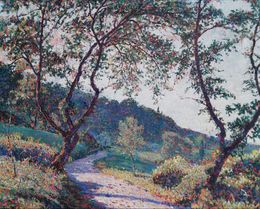
Paysage d'été style pointilliste
Ferruccio Manganelli
Painting - 58 x 71.5 x 2 cm Painting - 22.8 x 28.1 x 0.8 inch
Sold
He attended the Royal Professional School of Colle di Val d'Elsa and, at the same time, the evening drawing courses for workers, distinguishing himself in the field of ornamental and geometric design. Engaged in the production of decorative stucco, he often traveled to Lombardy (San Pellegrino, Milan, Monza) and Liguria. He switched from pencil drawing, which he preferred in portraiture, influenced by Antonio Salvetti, to oil color and pastels for landscapes, especially rural ones.
After 1914, the year of his marriage, he turned more and more towards color and Divisionist painting. He then participated in World War I as a fighter in the area of operations, where he was wounded and then hospitalized at the hospital in Alba, in the province of Cuneo. Back in Colle Val d'Elsa, he resumed his activity in the craft industry and continued to cultivate painting in the open air, which would help relieve the pain of the untimely death of his only son.
He participates in the cultural activities of his municipality with Mino Maccari. After the end of World War II, he produced a series of works based on the search for color and light and depicting the Tuscan countryside. He died in Colle di Val d'Elsa on November 20, 1968. In 1997, the municipality of Colle Val d'Elsa dedicated an exhibition to him which was held in the Crypt of Mercy.

Painting - 58 x 71.5 x 2 cm Painting - 22.8 x 28.1 x 0.8 inch
Sold
What are their 3 main works?
When was Ferruccio Manganelli born?